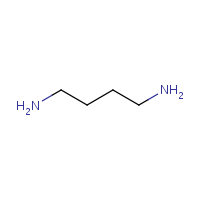Putrescine
Agent Name
Putrescine
Alternative Name
1,4-Diaminobutane
CAS Number
110-60-1
Formula
C4-H12-N2
Major Category
Nitrogen Compounds

Synonyms
1,4-Butylenediamine; 1,4-Diaminobutane; 1,4-Tetramethylenediamine; Butylenediamine; Putrescin; Tetramethyldiamine; Tetramethylenediamine; 1,4-Butanediamine; [ChemIDplus] Butane-1,4-diamine; [EFSA: DAR - Vol. 1] UN2928
Category
Amines, Aliphatic
Description
Colorless liquid with a strong odor like piperidine; mp = 23-24 deg C; [Merck Index] White solid; mp = 26.8 deg C; [EFSA: DAR - Vol. 1] White hygroscopic solid with an odor like amines; mp = 25-28 deg C; [Alfa Aesar MSDS]
Sources/Uses
Polyamine found in all cells and certain bacteria; Used in biochemical research; [Merck Index] One of three active ingredients (0.3%) in a non-lethal food attractant for the male and female Mediterranean Fruit Flies used on orchard, citrus, and other crops; [EFSA: DAR - Vol. 1]
Comments
Corrosive to rabbit skin; Causes severe damage to rabbit eyes; [ToxPlanet: EFSA: DAR - Vol. 1] Cause muscle contraction or spasticity in intraperitoneal lethal-doses studies of mice; Causes somnolence, ptosis, and urine changes in oral lethal-dose studies of rats; [RTECS] Causes burns; Inhalation may cause corrosive injuries to upper respiratory tract and lungs; Harmful by ingestion and skin absorption; Toxic by inhalation; Reproductive effects observed in experimental animals; [Alfa Aesar MSDS]
Biomedical References
Exposure Assessment
Vapor Pressure
4.12 mm Hg
Lethal Concentration
LC50 (rat) = 880-1,300 mg/m3/4hr
Explanatory Notes
The Guide in the Emergency Response Guidebook is for "Toxic solid, corrosive, organic, n.o.s."
Adverse Effects
Toxic Pneumonitis
Yes
Dermatotoxin
Skin burns
Diseases, Processes, and Activities Linked to This Agent
Processes
Industrial Processes with risk of exposure: